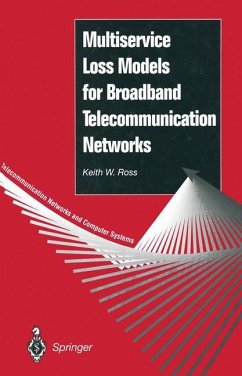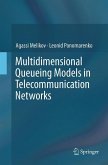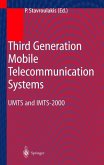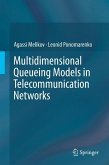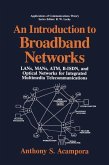Keith W. Ross
Multiservice Loss Models for Broadband Telecommunication Networks
Keith W. Ross
Multiservice Loss Models for Broadband Telecommunication Networks
- Broschiertes Buch
- Merkliste
- Auf die Merkliste
- Bewerten Bewerten
- Teilen
- Produkt teilen
- Produkterinnerung
- Produkterinnerung
Loss networks ensure that sufficient resources are available when a call arrives. However, traditional loss network models for telephone networks cannot cope with today's heterogeneous demands, the central attribute of Asynchronous Transfer Mode (ATM) networks. This requires multiservice loss models. This publication presents mathematical tools for the analysis, optimization and design of multiservice loss networks. These tools are relevant to modern broadband networks, including ATM networks. Addressed are networks with both fixed and alternative routing, and with discrete and continuous…mehr
Andere Kunden interessierten sich auch für
![Switching and Traffic Theory for Integrated Broadband Networks Switching and Traffic Theory for Integrated Broadband Networks]() Joseph Y. HuiSwitching and Traffic Theory for Integrated Broadband Networks161,99 €
Joseph Y. HuiSwitching and Traffic Theory for Integrated Broadband Networks161,99 €![Emerging Location Aware Broadband Wireless Ad Hoc Networks Emerging Location Aware Broadband Wireless Ad Hoc Networks]() Emerging Location Aware Broadband Wireless Ad Hoc Networks77,99 €
Emerging Location Aware Broadband Wireless Ad Hoc Networks77,99 €![Multidimensional Queueing Models in Telecommunication Networks Multidimensional Queueing Models in Telecommunication Networks]() Agassi MelikovMultidimensional Queueing Models in Telecommunication Networks39,99 €
Agassi MelikovMultidimensional Queueing Models in Telecommunication Networks39,99 €![Third Generation Mobile Telecommunication Systems Third Generation Mobile Telecommunication Systems]() Third Generation Mobile Telecommunication Systems121,99 €
Third Generation Mobile Telecommunication Systems121,99 €![Multidimensional Queueing Models in Telecommunication Networks Multidimensional Queueing Models in Telecommunication Networks]() Agassi MelikovMultidimensional Queueing Models in Telecommunication Networks39,99 €
Agassi MelikovMultidimensional Queueing Models in Telecommunication Networks39,99 €![ISDN Technology ISDN Technology]() J. R. BrewsterISDN Technology77,99 €
J. R. BrewsterISDN Technology77,99 €![An Introduction to Broadband Networks An Introduction to Broadband Networks]() Anthony S. AcamporaAn Introduction to Broadband Networks116,99 €
Anthony S. AcamporaAn Introduction to Broadband Networks116,99 €-
-
-
Loss networks ensure that sufficient resources are available when a call arrives. However, traditional loss network models for telephone networks cannot cope with today's heterogeneous demands, the central attribute of Asynchronous Transfer Mode (ATM) networks. This requires multiservice loss models.
This publication presents mathematical tools for the analysis, optimization and design of multiservice loss networks. These tools are relevant to modern broadband networks, including ATM networks. Addressed are networks with both fixed and alternative routing, and with discrete and continuous bandwidth requirements. Multiservice interconnection networks for switches and contiguous slot assignment for synchronous transfer mode are also presented.
This publication presents mathematical tools for the analysis, optimization and design of multiservice loss networks. These tools are relevant to modern broadband networks, including ATM networks. Addressed are networks with both fixed and alternative routing, and with discrete and continuous bandwidth requirements. Multiservice interconnection networks for switches and contiguous slot assignment for synchronous transfer mode are also presented.
Produktdetails
- Produktdetails
- Telecommunication Networks and Computer Systems
- Verlag: Springer / Springer London / Springer, Berlin
- Artikelnr. des Verlages: 978-1-4471-2128-2
- Softcover reprint of the original 1st ed. 1995
- Seitenzahl: 360
- Erscheinungstermin: 8. Dezember 2011
- Englisch
- Abmessung: 235mm x 155mm x 20mm
- Gewicht: 546g
- ISBN-13: 9781447121282
- ISBN-10: 1447121287
- Artikelnr.: 39494499
- Herstellerkennzeichnung Die Herstellerinformationen sind derzeit nicht verfügbar.
- Telecommunication Networks and Computer Systems
- Verlag: Springer / Springer London / Springer, Berlin
- Artikelnr. des Verlages: 978-1-4471-2128-2
- Softcover reprint of the original 1st ed. 1995
- Seitenzahl: 360
- Erscheinungstermin: 8. Dezember 2011
- Englisch
- Abmessung: 235mm x 155mm x 20mm
- Gewicht: 546g
- ISBN-13: 9781447121282
- ISBN-10: 1447121287
- Artikelnr.: 39494499
- Herstellerkennzeichnung Die Herstellerinformationen sind derzeit nicht verfügbar.
1 Multiservice Loss Systems.- 1.1 The Erlang Loss System.- 1.2 Loss Networks with Fixed Routing.- 1.3 Loss Networks with Dynamic Routing.- 1.4 The ATM Multiplexer.- 1.5 ATM Networks.- 1.6 Multiservice Interconnection Networks.- 2 The Stochastic Knapsack.- 2.1 The Model and Notation.- 2.2 Performance Evaluation.- 2.3 Virtual Channel Establishment for ATM Multiplexers.- 2.4 Contiguous Slot Assignment.- 2.5 Stochastic Comparisons.- 2.6 Monotonicity Properties for the Stochastic Knapsack.- 2.7 Asymptotic Analysis of the Stochastic Knapsack.- 2.8 The Stochastic Knapsack with Continuous Sizes.- 2.9 Bibliographical Notes.- 2.10 Summary of Notation.- 3 The Generalized Stochastic Knapsack.- 3.1 Preliminaries.- 3.2 A Recursive Algorithm.- 3.3 A Convolution Algorithm.- 3.4 Calculating Blocking Probabilities*.- 3.5 Refined Convolution Algorithms*.- 3.6 Monotonicity Properties.- 3.7 ATM with Burst Multiplexing.- 3.8 Circuit-Switched Access Networks.- 3.9 Sharing Memory*.- 3.10 Objects with Continuous Sizes*.- 3.11 Bibliographical Remarks.- 3.12 Summary of Notation.- 4 Admission Control.- 4.1 Admission Policies.- 4.2 Optimization Concepts.- 4.3 Optimal Complete Partitioning Policies.- 4.4 Optimal Coordinate Convex Policies.- 4.5 Markov Decision Processes.- 4.6 Optimal Admission to Broadband Multiplexers.- 4.7 Service Separation for ATM.- 4.8 Bibliographical Notes.- 4.9 Summary of Notation.- 5 Product-Form Loss Networks.- 5.1 The Model.- 5.2 Basic Properties.- 5.3 Algorithms for Generalized Access Networks.- 5.4 Algorithms for Hierarchical Access Networks.- 5.5 The Reduced Load Approximation for Single-Service Networks.- 5.6 The Reduced Load Approximation for Multiservice Networks.- 5.7 Implied Costs.- 5.8 Asymptotic Analysis.- 5.9 Loss Models for ATM Networks.- 5.10 ATM Networks: Route Separation.- 5.11 ATM Networks: Multiplexing Across Routes.- 5.12 Continuous Bandwidths*.- 5.13 Cellular Networks and Wavelength-Division Multiplexing Networks*.- 5.14 Bibliographical Notes.- 5.15 Summary of Notation.- 6 Monte Carlo Summation for Product-Form Loss Networks.- 6.1 The Theory of Monte Carlo Summation.- 6.2 Numerical Examples.- 6.3 Estimates for Revenue Sensitivity.- 6.4 Loss Network Analyzer: A Software Package.- 6.5 Bibliographical Notes.- 6.6 Summary of Notation.- 7 Dynamic Routing in Telephone Networks.- 7.1 An Overview of Contemporary Routing Techniques.- 7.2 Bounds on Average Revenue.- 7.3 Reduced Load Approximation for Dynamic Routing.- 7.4 Symmetric Networks.- 7.5 Computational Effort of Reduced Load Approximation.- 7.6 Computational Examples for the Reduced Load Approximation.- 7.7 Bibliographical Notes.- 7.8 Summary of Notation.- 8 Dynamic Routing in ATM Networks.- 8.1 ATM Routing Concepts.- 8.2 Static-Service, Dynamic-Route Separation.- 8.3 Static-Service Separation, Multiplexing Across Routes.- 8.4 Dynamic-Service, Dynamic-Route Separation.- 8.5 Dynamic-Service Separation, Multiplexing Across Routes.- 8.6 The Reduced Load Approximation for Multiservice Networks with Dynamic Routing.- 8.7 Bibliographical Notes.- 9 Multiservice Interconnection Networks.- 9.1 Model Description.- 9.2 Three-Stage Clos Networks.- 9.3 Cantor Networks.- 9.4 Rearrangeable Interconnection Networks.- 9.5 Bibliographical Notes.- 9.6 Summary of Notation.
1 Multiservice Loss Systems.- 1.1 The Erlang Loss System.- 1.2 Loss Networks with Fixed Routing.- 1.3 Loss Networks with Dynamic Routing.- 1.4 The ATM Multiplexer.- 1.5 ATM Networks.- 1.6 Multiservice Interconnection Networks.- 2 The Stochastic Knapsack.- 2.1 The Model and Notation.- 2.2 Performance Evaluation.- 2.3 Virtual Channel Establishment for ATM Multiplexers.- 2.4 Contiguous Slot Assignment.- 2.5 Stochastic Comparisons.- 2.6 Monotonicity Properties for the Stochastic Knapsack.- 2.7 Asymptotic Analysis of the Stochastic Knapsack.- 2.8 The Stochastic Knapsack with Continuous Sizes.- 2.9 Bibliographical Notes.- 2.10 Summary of Notation.- 3 The Generalized Stochastic Knapsack.- 3.1 Preliminaries.- 3.2 A Recursive Algorithm.- 3.3 A Convolution Algorithm.- 3.4 Calculating Blocking Probabilities*.- 3.5 Refined Convolution Algorithms*.- 3.6 Monotonicity Properties.- 3.7 ATM with Burst Multiplexing.- 3.8 Circuit-Switched Access Networks.- 3.9 Sharing Memory*.- 3.10 Objects with Continuous Sizes*.- 3.11 Bibliographical Remarks.- 3.12 Summary of Notation.- 4 Admission Control.- 4.1 Admission Policies.- 4.2 Optimization Concepts.- 4.3 Optimal Complete Partitioning Policies.- 4.4 Optimal Coordinate Convex Policies.- 4.5 Markov Decision Processes.- 4.6 Optimal Admission to Broadband Multiplexers.- 4.7 Service Separation for ATM.- 4.8 Bibliographical Notes.- 4.9 Summary of Notation.- 5 Product-Form Loss Networks.- 5.1 The Model.- 5.2 Basic Properties.- 5.3 Algorithms for Generalized Access Networks.- 5.4 Algorithms for Hierarchical Access Networks.- 5.5 The Reduced Load Approximation for Single-Service Networks.- 5.6 The Reduced Load Approximation for Multiservice Networks.- 5.7 Implied Costs.- 5.8 Asymptotic Analysis.- 5.9 Loss Models for ATM Networks.- 5.10 ATM Networks: Route Separation.- 5.11 ATM Networks: Multiplexing Across Routes.- 5.12 Continuous Bandwidths*.- 5.13 Cellular Networks and Wavelength-Division Multiplexing Networks*.- 5.14 Bibliographical Notes.- 5.15 Summary of Notation.- 6 Monte Carlo Summation for Product-Form Loss Networks.- 6.1 The Theory of Monte Carlo Summation.- 6.2 Numerical Examples.- 6.3 Estimates for Revenue Sensitivity.- 6.4 Loss Network Analyzer: A Software Package.- 6.5 Bibliographical Notes.- 6.6 Summary of Notation.- 7 Dynamic Routing in Telephone Networks.- 7.1 An Overview of Contemporary Routing Techniques.- 7.2 Bounds on Average Revenue.- 7.3 Reduced Load Approximation for Dynamic Routing.- 7.4 Symmetric Networks.- 7.5 Computational Effort of Reduced Load Approximation.- 7.6 Computational Examples for the Reduced Load Approximation.- 7.7 Bibliographical Notes.- 7.8 Summary of Notation.- 8 Dynamic Routing in ATM Networks.- 8.1 ATM Routing Concepts.- 8.2 Static-Service, Dynamic-Route Separation.- 8.3 Static-Service Separation, Multiplexing Across Routes.- 8.4 Dynamic-Service, Dynamic-Route Separation.- 8.5 Dynamic-Service Separation, Multiplexing Across Routes.- 8.6 The Reduced Load Approximation for Multiservice Networks with Dynamic Routing.- 8.7 Bibliographical Notes.- 9 Multiservice Interconnection Networks.- 9.1 Model Description.- 9.2 Three-Stage Clos Networks.- 9.3 Cantor Networks.- 9.4 Rearrangeable Interconnection Networks.- 9.5 Bibliographical Notes.- 9.6 Summary of Notation.

